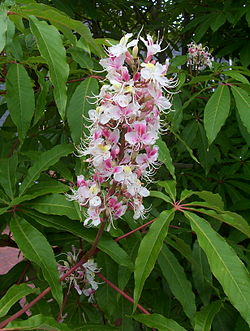Uses
Its leaves are used as cattle fodder in parts of Northern India. Its seeds are dried and ground into a bitter flour, called tattawakher. The bitterness is caused by saponins, which are rinsed out by thoroughly washing the flour during its preparation. The flour is often mixed with wheat flour to make chapatis [6] and also to make a halwa (Indian sweetmeat) and sometimes is served as a dalia, (a type of porridge or gruel) during fasting periods.
It is used in traditional Indian medicine for the treatment of various skin diseases and rheumatism, as well as functioning as an astringent, acrid, and narcotic. Additionally, it is employed to alleviate headaches. [6]
Its large leaves and flowers make it suitable for use as large-sized bonsai. [7]
In the UK, the cultivar 'Sydney Pearce'' has gained the Royal Horticultural Society's Award of Garden Merit. [8]
This page is based on this
Wikipedia article Text is available under the
CC BY-SA 4.0 license; additional terms may apply.
Images, videos and audio are available under their respective licenses.


